Mount Kilimanjaro measures 5,895 meters or 19,340 feet above sea level, from the base of the mountain to the summit, Uhuru Peak on Kibo which is its highest point on Kilimanjaro. Unquestionably a unique tourism attraction, Mount Kilimanjaro draws roughly 50,000 climbers annually. In addition to having stunning panoramic views and a distinct sense of adventure, this mountain is the tallest in Africa. Everyone who has done so may boast of having visited the “Roof of Africa.” Since the mountain was discovered and scaled to the summit, there have been many measurements taken to date. To summarize the actual height of this gigantic massif in Tanzania, we take an in-depth look into the confliction measurements done on the height of Kili, as it is popularly known.
- Mount Kilimanjaro’s official Height: is 5,895 m (19340 ft); utilized by, essentially, everyone.
- The more accurate Height of Mount Kilimanjaro: is 5,892.55 m (19322 ft), as found, for instance, in the UNEP/WCMC information page.
- According to the Kilimanjaro 2008 the more accurate Height Measurement Expedition, the current Kilimanjaro height is 5891.8 m (19330 ft).
Mount Kilimanjaro’s official elevation is 19,364 feet (5,895 meters). The sign atop Mount Kilimanjaro reads: “This information you are likely to discover all over the internet.” This is the amount that British cartographers determined in 1952. Hans Meyer assessed the height of Kilimanjaro during his ground-breaking ascent sixty years ago (he was the first person ever to reach Uhuru peak).
The tallest peak in Africa, according to Meyer’s estimation at the time, had an elevation of 6045 meters. For more than 60 years, this estimate ruled the academic landscape in Europe. Despite not having the right measuring equipment, Meyer managed to offer a very accurate value.
Since then, there has been a significant advancement in technology, and in 1999, a group of enthusiasts remeasured Kilimanjaro and determined that its actual height is 5892.55 meters. As we can see, the margin of error was not great, and the British team had done an excellent job estimating Kilimanjaro’s height forty years prior.
When Kilimanjaro was measured once more in 2008, the gauge revealed that the mountain’s true height was 5,891.8 meters.
The study team used GPS and graviter techniques, and we think this is the most precise estimate currently available.
It is unclear if Mount Kilimanjaro is actually receding or if the measurements made prior to 2008 were inaccurate.
In any event, there isn’t much of a difference to worry about between the 1952 British estimate and the following ones. The majority of websites, including the Altezza website, choose to use the standard measurement and state that Kilimanjaro is 5,895 meters tall.
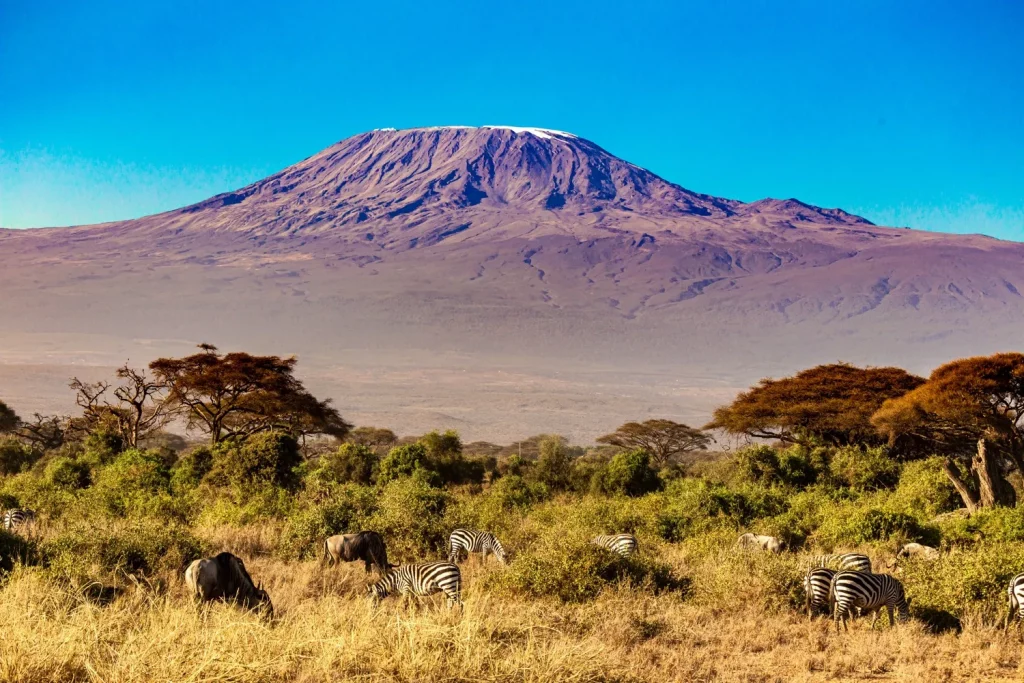
So how high is Mount Kilimanjaro?
Mount Kilimanjaro rises to a height of 5,895 meters (19,341 feet) above sea level. Its main peak is Uhuru Peak. Mount Everest, which is little over 2,950 meters higher than Mount Kilimanjaro, sits at 8,848 meters (29,029 feet), giving you an indication of the mountain’s height.
The tallest mountain in the world and the highest free-standing mountain is Mount Kilimanjaro. It is not a mountain range if it is free-standing.
However, it’s fascinating to note that Kilimanjaro’s peak is below both the South and North Everest Base Camps (EBC). However, it usually takes climbers upwards of 8 to 10 days to reach EBC.
It is extremely risky to begin the Kilimanjaro Climb in less than 5 days, despite the possibility. because there is a danger of Kilimanjaro Altitude Sickness due to Mount Kilimanjaro’s quick ascent.
World’s tallest free-standing mountain
The tallest free-standing mountain in the whole globe, not just in Africa, is Kilimanjaro. Every other high mountain is typically a component of a mountain range, where several other mountains may be seen.
For instance, Acongagua is part of the Andes, Elbrus is in the Caucasus, Everest is in the Himalayas, etc. As they approach these locations, climbers will discover that they are surrounded by additional mountains, hills, and elevations.
Tanzania’s mountains appear quite different because Kilimanjaro comes straight up from a level plain whereas Tanzania’s mountains are surrounded by a tropical jungle. Mount Meru is the closest mountain, however, there are almost 100 kilometers between the two summits. Kilimanjaro has an eerie, regal appearance, looming above the African savannah and inspiring strong sensations of success and adventure.
It’s fascinating to note that Kibo, Mawenzi, and Shira are the three volcanic cones that make up Kilimanjaro (however, Shira has been destroyed by an eruption).
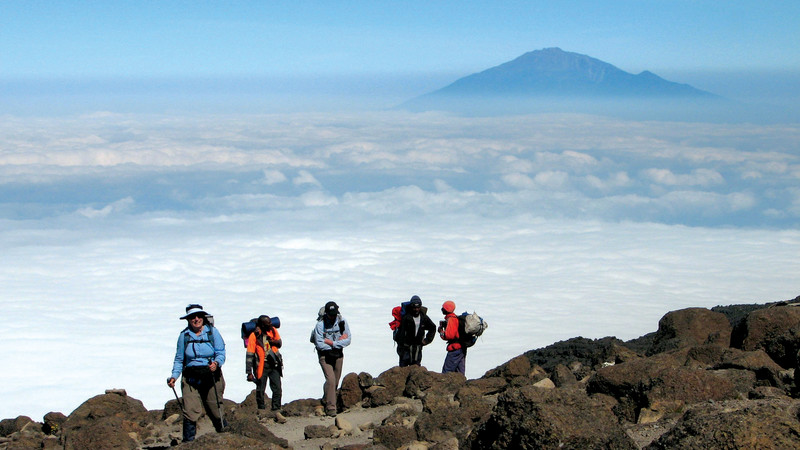
Highest Point on Mount Kilimanjaro – Uhuru Peak
At 5,895 meters above sea level, Uhuru Peak is the highest point on Mount Kilimanjaro, Africa’s tallest mountain. This peak on Kibo volcanic cone is also the highest point in Africa. Reaching Uhuru Peak, which is situated on the volcanic cone Kibo, which is a portion of Mount Kilimanjaro, is the ultimate objective of 20,000–35,000 hikers each year. Uhuru is a magnificent climb with lovely scenery in Tanzania.
For the tens of thousands of trekkers who attempt to climb Mount Kilimanjaro each year, Uhuru Peak is their ultimate aim. An astonishing 40% of people who undertake the walk actually reach the peak. Hikers may take guided hikes to the mountain using one of five to eight routes, all of which have varied degrees of difficulty, with the assistance of seasoned climbers.
Kibo – Highest Peak on Kilimanjaro
The heart of Kilimanjaro is Kibo. Kibo, the highest peak of Kilimanjaro (19,340 ft/ 5,895 m), is crowned by Uhuru Peak. It is here that the conclusion of what we refer to as a “real Kilimanjaro climb” takes place. There are all of the peak camps.
One can witness the renowned Ash Pit and Kilimanjaro glaciers in the Kibo crater area.
Barranco Wall, another well-known landmark of Mount Kilimanjaro, is located on Kibo’s southern slope. The view from the peak is nothing short of amazing and is only surpassed by the views from Uhuru Peak itself when Kilimanjaro trekkers pass over it on their route from Barranco Camp to Karanga Camp.
Mawenzi – Second Highest Peak
The second summit of Kilimanjaro is Mawenzi, which has a height of 5148 m (16,893 f). When ascending Mount Kilimanjaro by the Rongai route, one will get a fantastic view of it from Mawenzi Camp because it is situated on the eastern side of the enormous peak.
Please be aware that on standard Kilimanjaro climbs, hikers are not permitted to ascend Mawenzi. Mawenzi has rocky, extremely steep hills. While going to Uhuru Peak is a trek (albeit a difficult one), getting to the top of Mawenzi takes genuine alpine expertise. Ropes, carbines, and other equipment should be able to help one safely negotiate this treacherous ascent.
In addition, a special permit from the Kilimanjaro National Park Authority is required for this activity, which is only granted in exchange for payment of an additional fee for climbing Mawenzi in addition to the standard Mt. Kilimanjaro conservation and camping fees and the presentation of documentation demonstrating the climber’s proficiency in mountaineering.
Shira – Third Highest peak
Shira used to be Kilimanjaro’s third volcanic cone. A flat plateau ultimately developed when one of the early eruptions completely demolished the rim. Lemosho Glades is the name given to this area nowadays. Since then, it has developed into one of Mount Kilimanjaro’s most sweeping locations.
On Kilimanjaro’s Lemosho and Northern trails, hikers cross the plateau known as Shira.
KILIMANJARO HEIGHT VS. ELEVATION VS. CLIMBING HEIGHT VS. PROMINENCE
Travelers should be prepared to gain several meters in elevation each day when climbing Mount Kilimanjaro. Kilimanjaro’s elevation of 5,895 m (19,340 f) does not always correspond to the elevation acquired throughout the trek. Kilimanjaro’s whole region is located in the highlands, which are already elevated substantially above sea level. For instance, Moshi, the regional capital, is located 800 m (2,600 f) above sea level. Even higher are the majority of the trailheads. As a result, when climbing Kilimanjaro, trekkers will not truly gain 5,895 meters in elevation, they will stand at that height after they reach Uhuru Peak.
We have covered the “height” (measured in meters and feet) of Mount Kilimanjaro on this page. However, in actuality, we mean “elevation” when we refer to height. Instead, you’d want to know about “rising height” or “prominence.”
The height in relation to sea level is typically referred to as elevation. Elevation, then, is a more precise comparison of height to the generally recognized idea of sea level. But everyone is aware that tides cause sea levels to change.
Most people realize that there is a worldwide average sea level, but understanding it—or at least measuring it—can be challenging, especially when the water is thousands of kilometers distant and clearly visible. And of course, we live in a time when mountains are receding and sea levels are increasing.
What is the elevation of Mount Kilimanjaro?
By definition, altitude tries to describe how high something is in relation to the sea. Altitude, on the other hand, is typically used to define the vertical dimension of the lowest point of a structure hung in the air, whereas elevation specifies the vertical dimension of any standing building.
There are several ways to measure altitude. For instance, an altimeter uses its air pressure to measure height.
Air pressure and height are related, thus this is not a terrible idea. As long as you take into account how air pressure affects things like the weather. If not, they can result in a less accurate measurement.
The height from which you start to climb is referred to as the climbing height. The rising height and mountain’s elevation would be equivalent if you were ascending from sea level to the peak.
By deducting the elevation of the trailhead from the summit’s elevation, we can get an approximation of the ascending height. However, this doesn’t accurately reflect the height that must be physically ascended to reach the peak. Since nearly every mountain on Earth requires some further climbing and descending before reaching the peak.
Sometimes we might instead look for the mountain’s prominence, especially if a mountain has several paths and beginning locations or if the up-and-down character of the trail is so significant that ascending height becomes immaterial.
In topographic geography, “prominence” describes how much a peak rises vertically above its surroundings. However, the precise meaning of prominence is a little more intricate: The minimal distance one would have to go from a mountain’s top to the base of a higher peak is its prominence.
With a prominence of 8,848 meters (29,029 feet), Mount Everest is the tallest peak in the Himalayas, whereas Mt. Lhotse, whose overall height is an incredible 8,516 meters (27,940 feet), barely registers on lists of mountain prominence. This is because Lhotse shares a majority of its height with Everest.
Mt. Kilimanjaro ranks as the fourth “highest” mountain in the world with a prominence rating of 5,885m! Only Mount McKinley, Aconcagua, and Everest are higher.
Can you climb Mount Kilimanjaro without anybody else’s assistance? Yes, you can. The height of Mount Kilimanjaro won’t concern you all that much, but using a tour operator like Tranquil Kilimanjaro to climb the mountain is a safe and additional alternative because they offer rescue services as part of their climbing services.
Related: Can you climb Kilimanjaro solo?
History of Kilimanjaro’s Height measurement in meters and feet
It all started in 1889 when Dr. Hans Meyer, after three failed attempts, eventually succeeded in climbing to the summit of Kilimanjaro. Even though it was his third try, it was another 20 years before another climber succeeded in reaching the summit of Kilimanjaro.
Dr. Hans later said that he had climbed to a height of 6045 meters, or 19,833 feet. The height is obviously inflated. Later, that number was revised by German colonial officials to 5892 meters. Up until 1952, it continued to be the recognized height of Kilimanjaro.
British cartographers later that year mapped Mount Kilimanjaro. The height of Mount Kilimanjaro was now officially 5895 meters (19340 feet).
Additionally, this number was printed on the sign at Uhuru Peak. The majority of tools and informational materials regarding Kilimanjaro, including all websites, use this number.
However, the UNEP/WCMC (United Nations Environment Programme/World Conservation Monitoring Centre) lists Kilimanjaro’s height as 5893 meters in its official fact page about Kilimanjaro National Park.
The new height of Mount Kilimanjaro in Meters and feet
Clearly, technology has advanced much since 1952. In order to update the height of Kilimanjaro, a group of experts did so in 1999. They made advantage of the then-current GPS technology.
Previously, Mt. Everest was measured using GPS technology. The information showed that the height had decreased by a few meters. And the same thing happened to Mount Kilimanjaro.
The measured information was 5892.55 meters. Kilimanjaro thus decreased by 2.45 meters.
2008 saw a repeat of the process with more advanced technologies. The exercise was done once again. Surprise, too! Kilimanjaro is just 5,891.8 meters high as measured by the GPS and gravimeter right now! (19,330 ft).
We can presume that this most recent reading is the most precise.
However, it is still uncertain if the diminution in height is due to true shrinkage or incorrect technology from “back then”. Or perhaps a mix of the two.
Everyone continues to believe that Kilimanjaro is 5895 meters high.
If the height of Mount Kilimanjaro is sufficient for Kilimanjaro National Park to be listed as a UNESCO World Heritage Site, it should be sufficient for all of us.
Height of Kilimanjaro vs other mountains of the 7 summits
Mount Kilimanjaro is not just the tallest peak in Africa but one of the Seven Summits (i.e. highest mountains on each of the seven continents). The other peaks in the Seven Summits circuit are as follows:
- Mount Everest – Asia – 8,848 meters
- Aconcagua – South America – 6,961 meters
- Denali – North America – 6,194 meters
- Mount Kilimanjaro – Africa – 5,895 meters
- Mount Elbrus – Europe – 5,642 meters
- Mount Vinson – Antarctica – 4,892 meters
- Mount Kosciuszko – Australia – 2,228 meters
Here is an illustration that compares the Seven Summits’ relative heights to the Himalayas’ 14 tallest peaks.
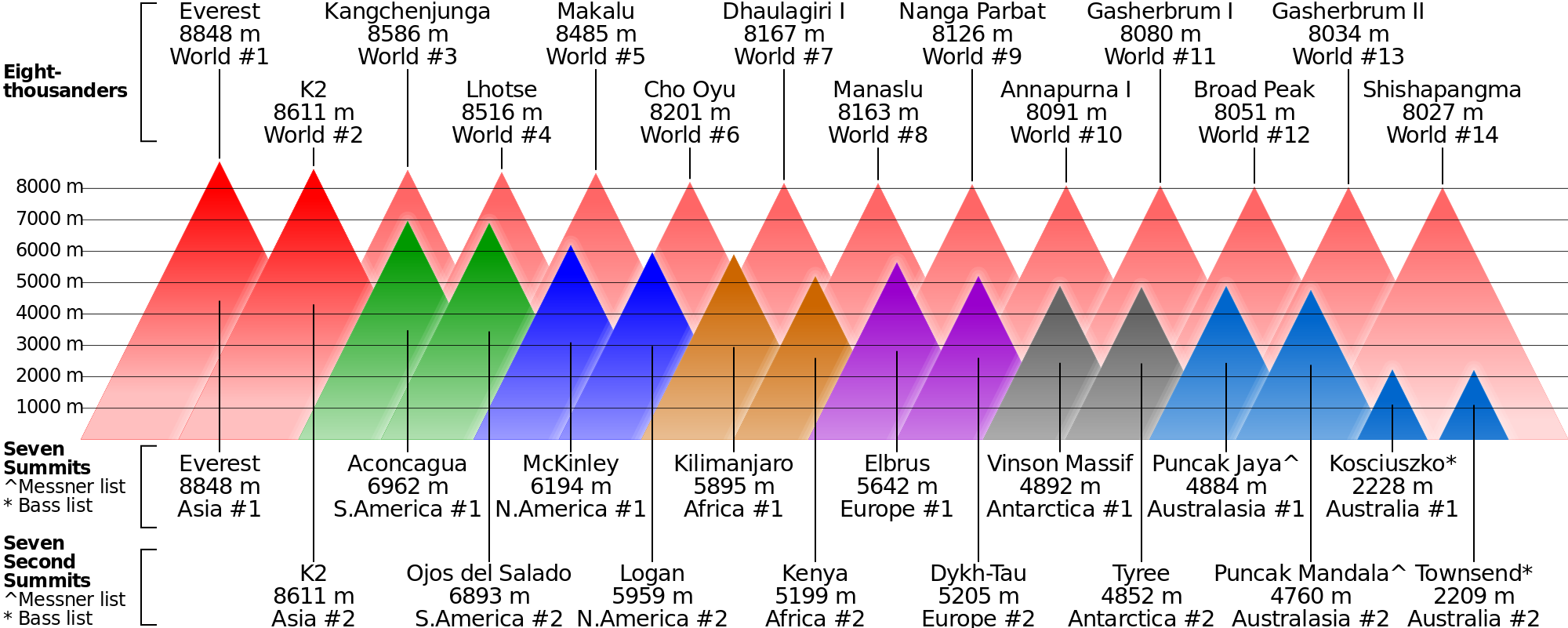
Comparing Kilimanjaro’s height with the 7 summit mountains
The tallest mountains on each of the seven continents are known as the Seven Summits.
One of the most prestigious achievements in any sport is to climb each of the Seven Summits, which are the highest peaks on each continent.
The mountains that make up the seven summits are determined by several territorial partition theories. Since the tallest mountain in Oceania is listed differently on the two most common rankings. The tallest summit in Australia is on one, Mount Kosciuszko, while Carstensz Pyramid is on the other.
Read more about the seven summits
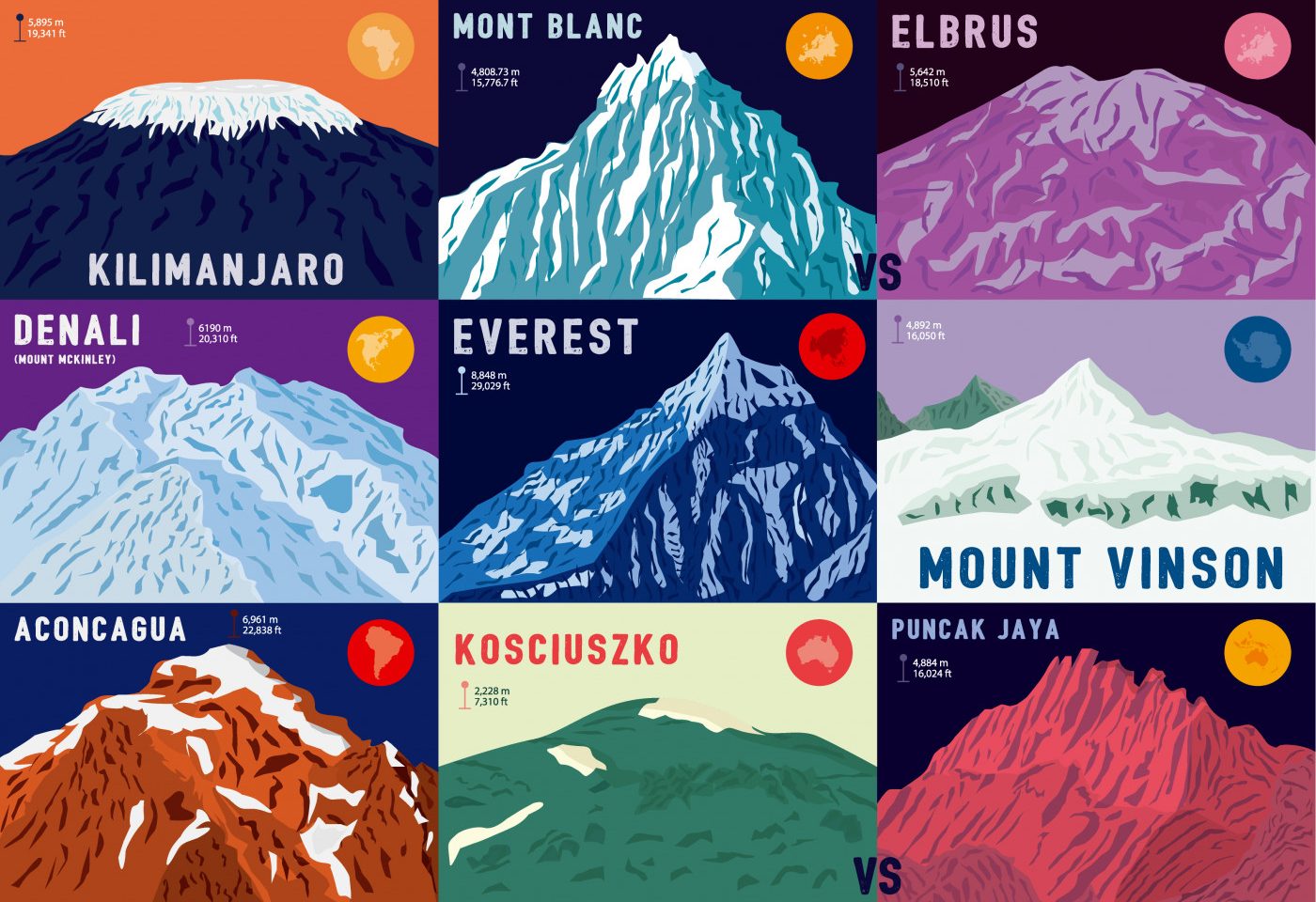
The Seven Summits:
- Asia: Everest (29,035 feet / 8,850 m) in Asia.
- South America: Aconcagua (22,829 feet / 6,962 m) in South America.
- North America: Denali (20,320 feet / 6,190 m) in North America.
- Africa: Kilimanjaro (19,340 feet / 5,895 m) in Africa.
- Europe: Elbrus (18,510 feet / 5,642 m) in Europe.
- Australia: Carstensz (16,023 feet / 4,884 m) or Mount Kosciuszko (7,310 feet / 2,228 m) in Oceania.
- Antarctica: Vinson (16,067 feet / 4,892 m) in Antarctica.
Frequently asked questions about Kilimanjaro’s height
Below are some of the common questions that people ask online concerning the height of Mount Kilimanjaro.
What Height Does Kilimanjaro Have?
Mount Kilimanjaro is located 4,900 meters (16,100 feet) above the plateau’s base and rises to a height of 5,895 meters (19,341 feet) above sea level. Three volcanic cones can be found on Mount Kilimanjaro, a dormant volcano in Tanzania (Kibo, Mawenzi and Shira). It is the tallest free-standing mountain in the whole world, not just in Africa.
![]()

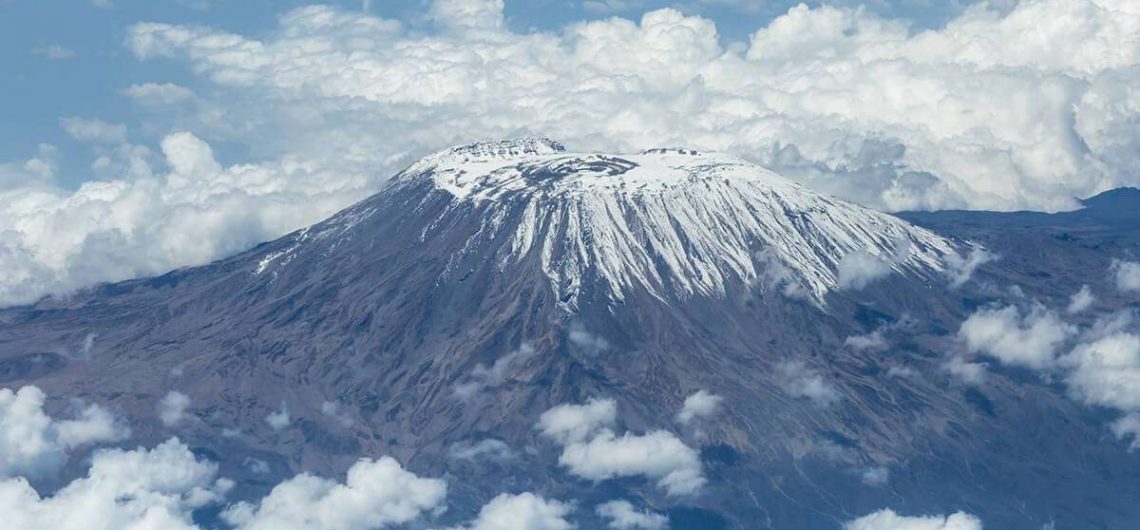
Comments